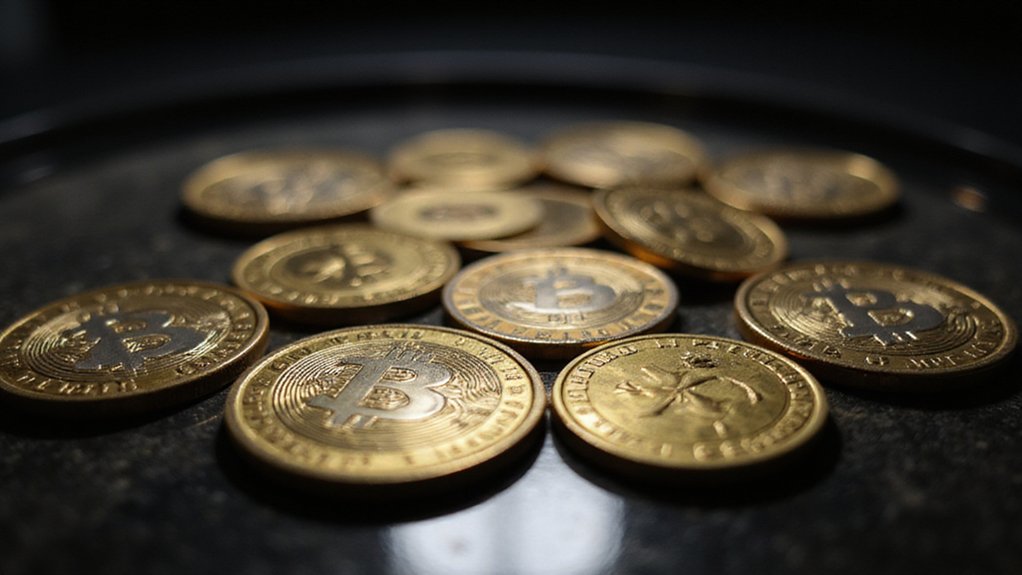Tokenomics—the portmanteau that somehow makes cryptocurrency sound academic—represents the economic architecture governing digital assets through supply mechanics, distribution strategies, and utility frameworks. These systems determine whether tokens function as governance instruments, access keys, or payment mechanisms within their respective ecosystems. Supply constraints create scarcity (theoretically), while distribution methods influence market dynamics and participant behavior. Token burns, staking rewards, and buyback mechanisms attempt to engineer sustainable demand cycles, though success depends entirely on collective confidence—a foundation that transforms further exploration into essential reading.

The curious marriage of “token” and “economics” has birthed tokenomics—a discipline that attempts to impose economic rationality on what often resembles digital alchemy.
Tokenomics transforms speculative crypto chaos into structured economic frameworks, bridging the gap between blockchain innovation and traditional financial principles.
This framework evaluates cryptocurrencies through fundamental economic principles, analyzing how tokens derive value from supply mechanics, distribution strategies, and utility propositions rather than mere speculative fervor.
Token supply represents the foundational element, determining scarcity through total circulation limits and issuance schedules.
Projects employ various distribution mechanisms—from traditional mining and proof-of-stake validation to initial coin offerings and community airdrops—each carrying distinct implications for market dynamics.
The allocation between development teams, early investors, and public participants creates power structures that influence long-term governance and price stability.
Utility drives sustainable demand beyond speculative trading.
Tokens function as governance instruments, enabling holders to vote on protocol changes and treasury allocations.
They serve as access keys to decentralized applications, payment methods within ecosystems, or collateral for complex financial instruments.
The velocity at which tokens circulate—how frequently they change hands—indicates whether users view them as stores of value or mere transactional tools.
Incentive structures attempt to align participant behavior with network health.
Staking rewards compensate validators for securing blockchain networks, while yield farming programs encourage liquidity provision.
Many projects implement liquidity mining programs where participants supply tokens into pools to earn rewards while increasing token tradability.
Token burns and buyback mechanisms theoretically reduce supply to support prices, though their effectiveness varies considerably across implementations.
Some projects implement burning mechanisms to create deflationary pressure by permanently removing tokens from circulation with each transaction.
Unlike traditional currencies backed by governments or institutions, cryptocurrency value depends entirely on collective confidence generated through effective tokenomics design.
Governance mechanisms range from simple majority voting to sophisticated delegation systems where token holders can proxy their voting power to specialized participants.
These structures determine how quickly protocols adapt to market conditions and technological developments, influencing competitive positioning within the broader cryptocurrency landscape.
Market impact emerges from the interplay between these components.
Well-designed tokenomics creates sustainable demand cycles where utility drives adoption, which increases token value, attracting more participants to strengthen the network.
Conversely, poorly structured token economies suffer from extreme volatility, low adoption rates, and eventual abandonment as participants migrate to more compelling alternatives.
Understanding tokenomics requires analyzing these interconnected systems rather than focusing on individual metrics, as successful cryptocurrency projects demonstrate coherent economic models that incentivize desired behaviors while maintaining long-term sustainability.
Frequently Asked Questions
How Do Token Burns Affect Long-Term Price Stability and Market Confidence?
Token burns create deflationary pressure by permanently reducing supply, theoretically supporting price stability when demand remains constant—though this assumes rational market behavior (a generous assumption in crypto).
Regular burning schedules demonstrate project discipline, fostering investor confidence through transparent economic management.
However, burns only work if underlying demand persists; without genuine utility, artificially induced scarcity becomes mere financial theater, potentially attracting regulatory scrutiny over suspected market manipulation.
What Are the Tax Implications of Holding Different Types of Crypto Tokens?
Crypto token taxation varies considerably by classification—utility tokens face capital gains treatment as property, while security tokens navigate both securities law and tax obligations.
NFTs follow standard property rules, though stablecoins occupy an evolving regulatory gray area.
Token burns (previously discussed for price stability) create taxable events requiring basis calculations, while holders must track every transaction meticulously.
The IRS’s expanding classification authority adds delightful uncertainty to an already complex compliance landscape.
Can Tokenomics Models Be Changed After a Cryptocurrency Project Launches Successfully?
Yes, tokenomics models can absolutely be modified post-launch through various mechanisms.
Projects employ decentralized governance voting, protocol amendments, and strategic adjustments like token burns or revised staking incentives.
These changes—while potentially affecting investor confidence and market dynamics—allow projects to adapt to evolving circumstances.
Polkadot’s structured vesting schedules and Filecoin’s foundation allocations exemplify how successful projects strategically modify their economic frameworks to maintain competitive positioning and ecosystem growth.
How Do Governance Tokens Actually Influence Real Decision-Making Within Blockchain Projects?
Governance tokens translate theoretical voting rights into tangible influence through weighted decision-making mechanisms—token holders’ voting power corresponds directly to their holdings, creating plutocratic structures where wealth determines influence.
Proposals undergo community evaluation via on-chain voting, with outcomes automatically executed through smart contracts.
This system enables stakeholders to shape protocol upgrades, treasury allocations, and strategic directions, though one might question whether such concentration of power truly represents decentralized governance.
What Happens to Tokenomics When a Project Transitions From Testnet to Mainnet?
The testnet-to-mainnet shift transforms tokens from worthless experimentation tools into tradeable assets with real economic consequences.
Projects must suddenly address market volatility, regulatory scrutiny, and genuine financial risk—quite the leap from sandbox economics.
Token distribution models require immediate recalibration, while governance structures (previously theoretical) face actual stakeholder pressure.
Supply mechanisms demand careful management to prevent inflation or deflation disasters that could torpedo investor confidence before the project establishes market legitimacy.









